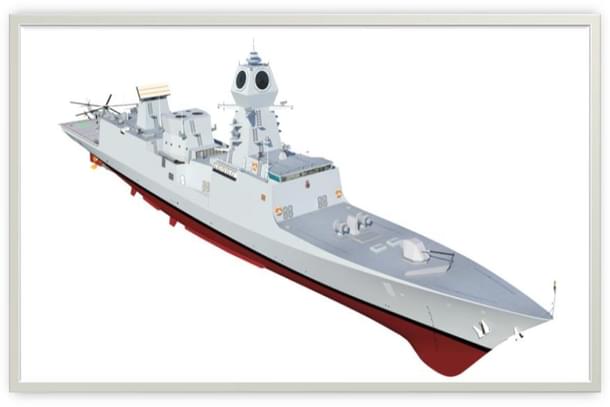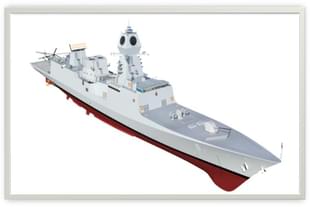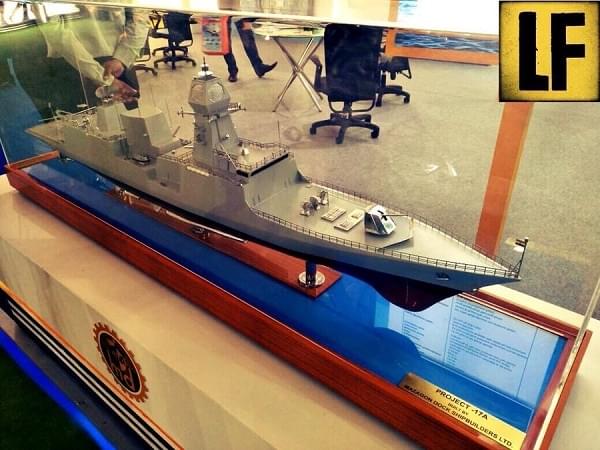Defence
How Capable Is Indian Navy's 'INS Vindhyagiri' Frigate That President Droupadi Murmu Launched Today In Kolkata
Ujjwal Shrotryia
Aug 17, 2023, 05:39 PM | Updated 05:39 PM IST
Save & read from anywhere!
Bookmark stories for easy access on any device or the Swarajya app.


President Droupadi Murmu launched the Indian Navy's frigate INS Vindhyagiri from the Garden Reach Shipbuilders and Engineers (GRSE) facility in Kolkata.
The newly launched frigate, INS Vindhyagiri, is the sixth stealth frigate constructed under Project-17 Alpha.
Project-17 Alpha, also known as the Nilgiri class frigate project, involves the construction of seven new-generation stealth frigates for the Indian Navy using advanced technologies. These frigates are being built by two state-run shipyards — Mazagon Docks Limited (MDL) and GRSE.
MDL is responsible for manufacturing four frigates — INS Nilgiri, Udaygiri, Taragiri, and Mahendragiri — while GRSE will manufacture the remaining three frigates, INS Himgiri, Dunagiri, and Vindhyagiri.
The first two ships are expected to be delivered to the Navy by 2024, with the remaining five being inducted by 2026.
These ships are follow-on versions of the three Project-17 vessels, also known as the Shivalik class frigates in the Indian Navy.
The Nilgiri class frigates are stealthier than the Shivalik class and incorporate various next-generation technologies.
Armed with eight BrahMos supersonic anti-ship and land-attack cruise missiles, the 149-meter frigate pack a formidable punch.
INS Vindhyagiri will be powered by two diesel engines for fuel-efficient propulsion and two US-made General Electric LM2500 gas turbines, enabling the frigate to travel at a maximum speed of over 30 knots.

The flush-deck design and significant use of composite materials, including radar absorbent materials, on Vindhyagiri reduce its radar cross-section (RCS), making it harder to detect and engage using anti-ship missiles.
The combination of two triple-tube 324mm torpedo launchers and two RBU-6000 anti-submarine launchers with the Bharat Electronics Limited (BEL) hull-mounted sonar advanced next-generation (HUMSA-NG) sonar gives the frigate all-round anti-submarine warfare (ASW) capability.
The Israeli EL/M-2248 Multi-function surveillance, track, and guidance radar (MF-STAR) provides exceptional situational awareness capabilities to the frigate.
The EL/M-2248 can detect a fighter jet-sized target from a maximum range of over 400 km.
The radar can also detect sea-skimming anti-ship missiles at a range of 25 km and guide 32 Barak-8 Medium-Range Surface-to-Air Missiles (MRSAM), enhancing its anti-air capabilities.
The Indra LTR-25 Lanza, a secondary radar, also provides the frigate with detection capability of fighter sized targets of over 450 km. It can also operate in a dense electronic warfare (EW) environment.
The 6,670-tonne frigate will be equipped with an indigenously designed CMS-17A combat management system, providing highly sophisticated and secure data links for uninterrupted interoperability among multiple navy surface and aerial assets.
According to reports, Vindhyagiri will have significant Made in India content, with nearly 75 per cent of components sourced from domestic micro, small, and medium enterprises (MSMEs).
Staff Writer at Swarajya. Writes on Indian Military and Defence.





